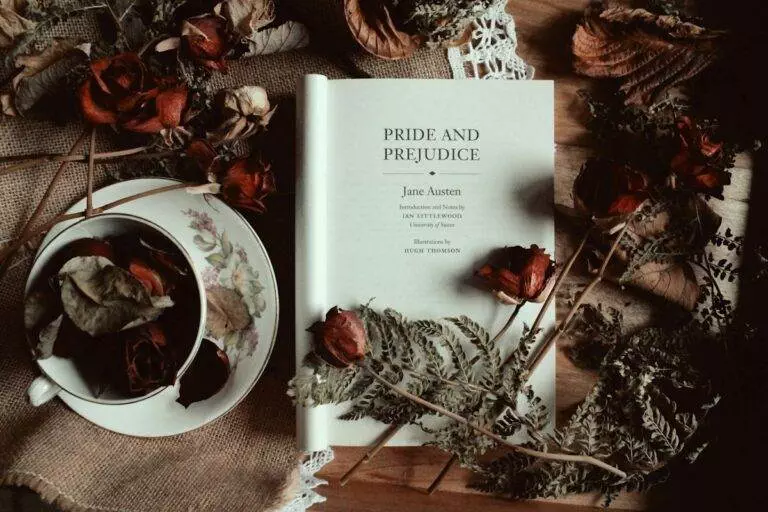Published in 1813, Jane Austen’s Pride and Prejudice is considered one of the greatest novels in English literature. A classic comedy of manners, it follows the turbulent romantic journey of Elizabeth Bennet, the feisty protagonist who must overcome her prejudices to find love. Through portrayals of families, class, scandal, and relationships in early 19th century British society, Austen crafts a delightful social satire with enduring insights on marriage, womanhood and human foibles.
Table of Contents
Plot Summary
Set in the English countryside, the story revolves around the Bennet family comprising the sarcastic Elizabeth, her reserved sister Jane, pretentious Mr. Bennet and the matchmaking Mrs. Bennet. Wealthy bachelor Mr. Bingley arrives in town sparking Mrs. Bennet’s schemes to marry one of her daughters to him. At a ball, Elizabeth immediately clashes with Bingley’s proud friend Mr. Darcy due to his rude behavior.
When Jane falls in love with Bingley, Mrs. Bennet’s plots are thwarted by Darcy and Bingley eventually moves away. Meanwhile soldier Wickham tells Elizabeth how Darcy cheated him out of an inheritance, confirming her negative view of Darcy. Over time however, Darcy falls for Elizabeth which leads her to re-examine her judgments about him and admit her own pride. Ultimately, she accepts Darcy’s second proposal and they marry.
Themes and Analysis
Key themes and ideas discussed in Pride and Prejudice:
- Role of social class, reputation and wealth in Regency England society
- Marriage as a social and economic institution, especially for women
- Danger of excessive pride and prejudice
- Balance between judgment and emotion in relationships
- Contrast between superficial and genuine virtue
- Satire of social snobbery, propriety and hypocrisy
- Changing landscape for women in the 19th century
Austen is renowned for her sharp social observation and wit. She balances caricature with empathy for human folly. Not just light comedy, Pride and Prejudice contains serious critiques on gender, economics and morality beneath the humor. Her free-indirect discourse reflects private thoughts.
Despite being restricted by conventions, the outspoken, intelligent Elizabeth pioneered independent heroines in fiction. Her sparring with arrogant yet complex Darcy is unforgettable.

Read This Too: Treasure Island – Robert Louis Stevenson’s Iconic Pirate Adventure
Jane Austen and Regency England
Jane Austen was born in 1775 in Hampshire as part of the rural gentry class. She began writing as a teenager focusing on romantic tales set in familiar upper class environments. Her novels including Pride and Prejudice critique and satirize British landed society.
Key historical context:
- The Regency period under King George III noted for order and elegance.
- Rural country estates coexisting with expanding towns and cities.
- Rigid social hierarchy with landed gentry at the top. Wealth was tied to land.
- Inheritance and marriage as means of acquiring status for women.
- Reputation and propriety prized above all. Social conduct strictly policed.
- Constraints on women’s education and independence.
Pride and Prejudice stands out for emphasizing emotional fulfillment in marriage despite social pressures. Austen gave glimpses of female desire within Regency constraints.
Analysis of Characters
Elizabeth Bennet – The second eldest Bennet daughter, intelligent and independent-minded but misjudges Darcy initially due to her prejudice.
Fitzwilliam Darcy – The handsome high-class bachelor attracted to Elizabeth despite her lower status. Though arrogant, he is virtuous at heart.
Jane Bennet – Elizabeth’s gentle elder sister who falls in love with Bingley. She thinks well of everyone.
Mr. Bennet – The sarcastic patriarch of the Bennets who copes with his foolish wife through dry wit.
Mrs. Bennet – A woman desperate to marry her daughters to wealthy men. Provides comic relief but reveals social pressures.
Mr. Wickham – The militia officer who earns Elizabeth’s sympathy by accusing Darcy. Eventually revealed as an unscrupulous seducer.
Significance and Impact
Pride and Prejudice is considered a pioneering novel for its empathetic heroines and social commentary:
- One of the first romantic comedies in English literature looking at courtship and marriage.
- Elizabeth Bennet as the archetypal witty, independent heroine. She challenged passive femininity.
- Established Austen as pioneering female voice known for irony and social observation.
- Sparked romantic fiction movement in 19th century England that endures globally today.
- Mr. Darcy popularized the wealthy aloof romantic hero redeemed by love trope.
- Depicted women actively evaluating men as romantic partners, subverting gender norms.
- Its satire of social pretensions and marriage politics retains relevance.
- Adaptations into movies, TV series, stage productions helped drive Austen’s popularity.
- Emphasized emotional companionship within marriage beyond economics.
Why Read Pride and Prejudice
Here are some of the main reasons for Pride and Prejudice’s enduring appeal:
- Austen’s witty observational prose and dialogue is superb.
- Lizzie Bennet remains one of literature’s most beloved heroines.
- The romance between Darcy and Elizabeth inspired countless fictional couples.
- It’s a comedy of manners that still resonates about society, gender and marriage.
- The characters are unforgettable, cleverly drawn caricatures.
- It expanded the subjects women’s writing addressed in the 19th century.
- The social satire and commentary are incisive.
- Austen crafted insightful portraits of family, community and relationships.
- The novel highlights women’s dependence on marriage due to economics and social standing.
- The writing style feels remarkably easy, intimate and modern.
Read This Too: The Adventures of Tom Sawyer – Mark Twain’s Ode to Boyhood
Conclusion
With its brilliant social satire and vivacious heroine, Pride and Prejudice showcases Jane Austen’s enduring talent for capturing human folly. Elizabeth and Darcy’s verbal sparring and ultimate union modeled countless fictional romances to come. Above all, it endures as a love story for the ages. Two hundred years later, Pride and Prejudice continues to delight readers while retaining its insight into society, relationships and the heart.



2 Comments
Pingback: A Christmas Carol - Charles Dickens' Enduring Holiday Morality Tale - LitGram by MukeshRishit
Pingback: A Feminist Reading of Jane Austen's Pride and Prejudice - LitGram by MukeshRishit